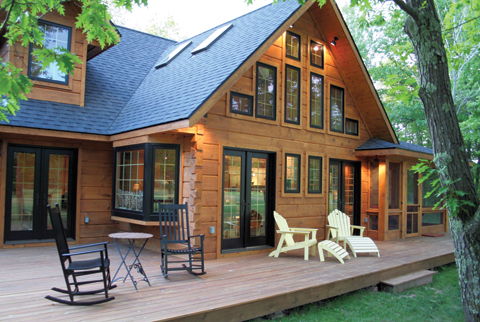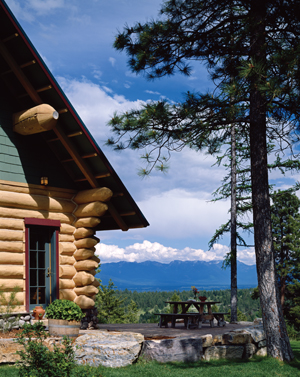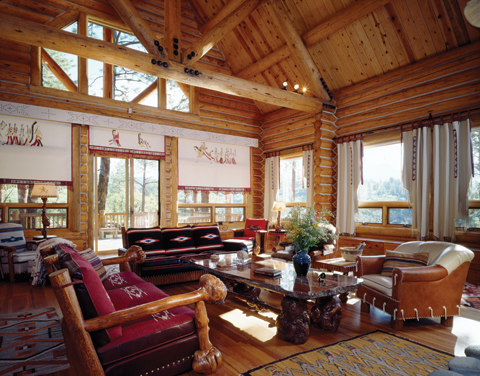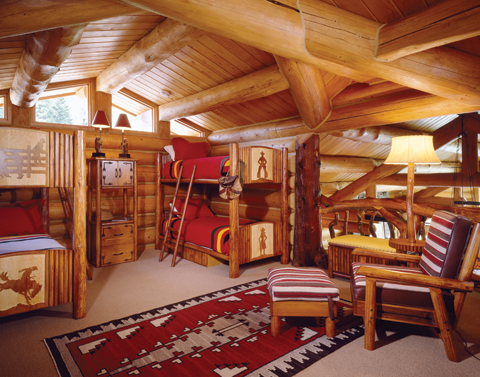You’ve set your sights on your ideal second home, and it’s time to bring your dreams to fruition. You’ve picked the site, purchased the land, and decided that a log home will be the perfect fit. In your mind’s eye you see your friends and family enjoying the home for years to come, frolicking in the lake that it overlooks and exploring the wilderness that surrounds it.
To make sure that vision becomes a reality, there are a few steps you’ll want to take during your second home’s design and build phase. There are also some important maintenance considerations that you won’t want to overlook, since the care and feeding of a second log home can be different from that of a primary residence.
Similarities and Differences
Greg Grimes, a partner with Expedition Log Homes in Cedar Grove, Wisconsin, says those differences start during the design phase, which second homeowners tend to approach very differently than they would a primary log home. “For a first home, consumers are looking at how to create individual spaces that flow well and allow them to live their lives on a day-to-day basis,” says Grimes. “All of that is pretty much thrown out the window when you’re building a vacation home.”
For example, Grimes says second home buyers aren’t necessarily thinking about how to create bedrooms where family members can have their own “space.” Instead, they’re looking at the potential for large, open gathering spots where family can get together on holidays and weekends to enjoy their lakefront or mountain log home. “Second home owners are thinking about mingling and getting together,” says Grimes, who adds that the inclusion of wide-open cathedral ceilings, lofts (for the kids to sleep in), and eat-in kitchens with breakfast bars are popular among vacation log home buyers.

Strongwood Log & Timber Homes
Those considerations carry over to the construction phase, where time constraints are usually looser than they would be with a first home. “Many times owners will tell their builders to get the home weather-tight and insulated, and that they’ll finish the rest of the home on their own,” says Grimes. “The process just isn’t driven by the same deadlines that exist for a primary home.”
Bob Marcom, director of sales and marketing at Strongwood Log Home Company in Waupaca, Wisconsin, says location also plays an important role in second log home development, mainly because most of them are situated far from the owner’s primary home. “Usually they involve a piece of property that’s 100 or 200 miles away, in an area that the owner isn’t familiar with,” says Marcom, who advises homeowners to conduct a site survey prior to commencing construction.
That survey—which should be done by a log home dealer or builder in the vicinity of your new home—will reveal whether water is available and
its source, and also give you valuable insights like utility and Internet accessibility, the latter of which has become a key consideration over the last few years. “When you go to your vacation home for the weekend, you’ll be bringing your laptop or notebook,” says Marcom, “and you’ll want Internet access.”
The Long Term
Second log homes are meant to be gems that are enjoyed on the weekends, holidays, and vacations. Unfortunately, that means these structures sit empty a lot and require special attention to ensure that when you do unlock that front door on the weekends, everything is in order and the place is ready to host a crowd for a few days.
“When you visit your home for the weekend, you don’t want to spend your time tackling home maintenance projects,” says Grimes. “You want to relax and enjoy yourself.”
For that reason, Grimes says second log home buyers often seek out low-maintenance options during the design and build phases. “They’re always looking for ways to make their homes more maintenance-friendly,” says Grimes. Deeper overhangs situated over decks and patios (both of which are very popular on second homes), for example, will protect the logs from the sun’s damaging UV rays. Half-log construction is another popular option, says Grimes.
“With a full-log structure, there will be some settling and porch posts that will need to be adjusted to match that settling,” says Grimes. “Half-logs look like full-logs, but they’re basically siding, and therefore don’t create those settling and maintenance issues.”
Living Projects
Regardless of the construction materials used, Grimes says second home owners should at minimum walk the perimeter of their cabins once a year to look for any caulking seams that need to be touched up, or any other areas that might need attention. Stain should be reapplied every five years, he adds, with that schedule depending on how much or how little UV exposure the home has.
Nicole Robinson, vice president at Log Homes of America in Jefferson, North Carolina, also suggests equipment like tankless water heaters, which ensure that you and your guests can take a hot shower without having to wait for a hot water heater to do its job. And be sure to plan for potential weather conditions, Robinson says, noting that homes in colder climates should be winterized (the heat should be left on a low setting throughout the winter, for example).
“Log homes don’t like to be shut up and left alone; they are living projects,” says Robinson. “If you keep this in mind, you’ll be able to enjoy your second home while also maintaining its beauty and functionality.”



